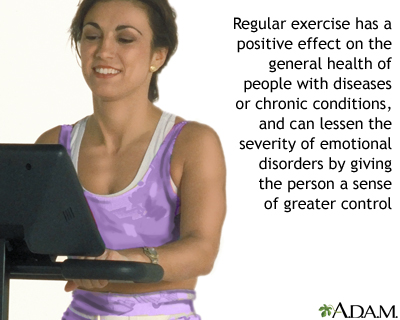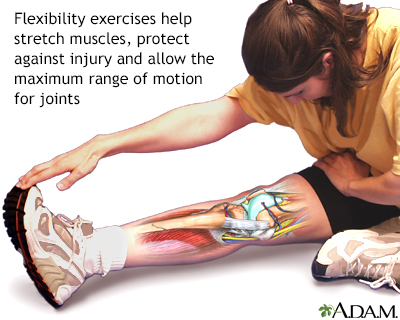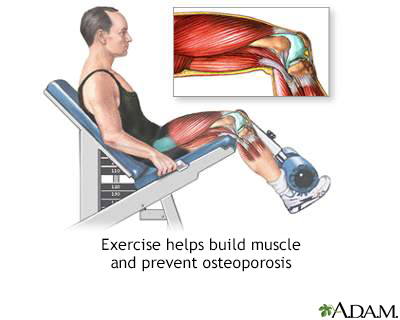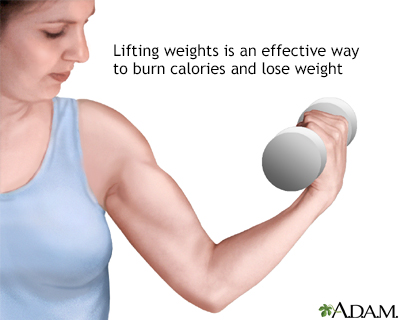Exercise and age
 Print-Friendly
Print-Friendly
Age and exercise
It is never too late to start exercising. Exercise has benefits at any age. Staying active will allow you to continue being independent and the lifestyle you enjoy. The right kinds of regular exercise can also reduce your risk of heart disease, diabetes, and falls.
I Would Like to Learn About:
Information
You don't need to spend hours in the gym every day to see benefits. Moving your body just 30 minutes a day is enough to improve your health.
An effective exercise program needs to be fun and helps to keep you motivated. It helps to have a goal. Your goal might be to:
- Manage a health condition
- Reduce stress
- Improve your stamina
- Be able to buy clothes in a smaller size
Your exercise program may also be a way for you to socialize. Taking exercise classes or exercising with a friend are both good ways to be social.
You may have a hard time starting an exercise routine. Once you do start, though, you will begin to notice the benefits, including improved sleep and self-esteem.
Exercise and physical activity can also:
- Improve or maintain your strength and fitness
- Make it easier to do the things you want to do
- Help your balance and walking
- Help with feelings of depression or anxiety and improve your mood
- Maintain your thinking skills (cognitive function) as you get older
- Prevent or treat diseases such as diabetes, heart disease, high blood pressure, breast and colon cancer, and osteoporosis
Always talk to your health care provider before starting an exercise program. Your provider can suggest exercises and activities that are right for you.
Exercises can be grouped into four main categories, although many exercises fit into more than one category:
AEROBIC EXERCISE
Aerobic exercise increases your breathing and heart rate. These exercises help your heart, lungs, and blood vessels. They may prevent or delay many diseases, such as diabetes, colon and breast cancers, and heart disease.
- Aerobic sports activities include brisk walking, jogging, swimming, biking, climbing, tennis, and basketball
- Aerobic activities you can do every day include dancing, yard work, pushing your grandchild on a swing, and vacuuming
MUSCLE STRENGTH
Improving your muscle strength can help you climb stairs, carry groceries, and stay independent. You can build muscle strength by:
- Lifting weights or using a resistance band
- Performing everyday activities, such as carrying a full laundry basket from the basement, carrying your smaller grandchildren, or lifting things in the garden
BALANCE EXERCISES
Balance exercises help prevent falls, which is a concern for older adults. Many exercises that strengthen the muscles in the legs, hips, and lower back will improve your balance. It is often best to learn balance exercises from a physical therapist before starting on your own.
Balance exercises may include:
- Standing on one foot
- Walking heel-to-toe
- Tai chi
- Standing on tiptoe to reach something on the top shelf
- Walking up and down the stairs
STRETCHING
Stretching can help your body stay flexible. To stay limber:
- Learn shoulder, upper arm, and calf stretches
- Take yoga classes
- Do everyday activities, such as making your bed or bending over to tie your shoes
Related Information
| Exercise - InDepth... |
References
Centers for Disease Control and Prevention website. Physical Activity Basics. Physical activity for older adults: an overview. www.cdc.gov/physical-activity-basics/guidelines/older-adults.html. Updated December 22, 2023. Accessed June 25, 2024.
Piercy KL, Troiano RP, Ballard RM, et al. The physical activity guidelines for Americans. JAMA. 2018;320(19):2020-2028. PMID 30418471 pubmed.ncbi.nlm.nih.gov/30418471/.
Theou O, Rose DJ. Physical activity for successful aging. In: Fillit HM, Rockwood K, Young J, eds. Brocklehurst's Textbook of Geriatric Medicine and Gerontology. 8th ed. Philadelphia, PA: Elsevier; 2017:chap 99.







